A Tunable Microstrip-to-Waveguide Transition for Emergency Satellite Communication Systems
Abstract
1. Introduction
2. Transition Design
3. Experiment Results and Discussion
4. Discussion
5. Conclusions
Author Contributions
Funding
Data Availability Statement
Conflicts of Interest
References
- Alagöz, F.; Gür, G. Energy efficiency and satellite networking: A holistic overview. Proc. IEEE 2011, 99, 1954. [Google Scholar] [CrossRef]
- Darwish, T.; Kurt, G.K.; Yanikomeroglu, H.; Bellemare, M.; Lamontagne, G. LEO satellites in 5G and beyond networks: A review from a standardization perspective. IEEE Access 2022, 10, 35040. [Google Scholar] [CrossRef]
- Yuan, D.; Qin, Y.; Wu, Z.; Shen, X. An emergency positioning system fusing GEO satellite Doppler observation and INS for SOTM. IEEE Trans. Instrum. Meas. 2021, 70, 8503804. [Google Scholar] [CrossRef]
- Guo, S.; Li, G.; Zheng, J.; Ren, Q.; Wu, Y.; Shen, G.; Yue, H. Integrated navigation and communication service for LEO satellites based on BDS-3 global short message communication. IEEE Access 2023, 11, 6623. [Google Scholar] [CrossRef]
- Leyva-Mayorga, I.; Soret, B.; Röper, M.; Wübben, D.; Matthiesen, B.; Dekorsy, A.; Popovski, P. Leo small-satellite constellations for 5G and beyond-5G communications. IEEE Access 2020, 8, 184955. [Google Scholar] [CrossRef]
- Tang, X.; Zang, Y.; Li, X.; Xu, C. A metamaterial bandpass filter with end-fire coaxial coupling. Electronics 2024, 13, 3158. [Google Scholar] [CrossRef]
- Li, S.; Yao, Y.; Cheng, X.; Yu, J. Design of a dual-band filter based on the band gap waveguide. Electronics 2024, 13, 3982. [Google Scholar] [CrossRef]
- Yang, L.; Zhu, X.; Gómez-García, R. High-order quasi-elliptic-type wideband bandpass filter with ultrabroad input-reflectionless stopband range. IEEE Microw. Wirel. Technol. Lett. 2023, 33, 655. [Google Scholar] [CrossRef]
- Rahmat-Samii, Y.; Densmore, A.C. Technology trends and challenges of antennas for satellite communication systems. IEEE Trans. Antennas Propag. 2015, 63, 1191–1204. [Google Scholar] [CrossRef]
- Yang, Z.; Browning, K.C.; Warnick, K.F. High-efficiency stacked shorted annular patch antenna feed for Ku-band satellite communications. IEEE Trans. Antennas Propag. 2016, 64, 2568. [Google Scholar] [CrossRef]
- Montori, S.; Cacciamani, F.; Gatti, R.V.; Sorrentino, R.; Arista, G.; Tienda, C.; Encinar, J.A.; Toso, G. A transportable reflectarray antenna for satellite Ku-band emergency communications. IEEE Trans. Antennas Propag. 2015, 63, 1393. [Google Scholar] [CrossRef]
- Topak, E.; Hasch, J.; Zwick, T. Compact topside millimeter-wave waveguide-to-microstrip transitions. IEEE Microw. Wirel. Compon. Lett. 2013, 23, 641. [Google Scholar] [CrossRef]
- Kim, J.; Choe, W.; Jeong, J. Submillimeter-wave waveguide-to-microstrip transitions for wide circuits/wafers. IEEE Trans. Terahertz Sci. Technol. 2017, 7, 440. [Google Scholar] [CrossRef]
- Liu, Z.; Xu, J.; Wang, W. Wideband transition from microstrip line-to-empty substrate-integrated waveguide without sharp dielectric taper. IEEE Microw. Wirel. Compon. Lett. 2019, 29, 20. [Google Scholar] [CrossRef]
- Xu, Z.; Xu, J.; Qian, C. Novel In-line microstrip-to-waveguide transition based on E-plane probe T-junction structure. IEEE Microw. Wirel. Compon. Lett. 2021, 31, 1051. [Google Scholar] [CrossRef]
- Wu, C.; Zhang, Y.; Li, Y.; Zhu, H.; Xiao, F.; Yan, B.; Xu, R. Millimeter-wave waveguide-to-microstrip inline transition using a wedge-waveguide iris. IEEE Trans. Microw. Theory Tech. 2022, 70, 1087. [Google Scholar] [CrossRef]
- Yuan, B.; Wu, P.; Yu, Z.; Hao, C. Wideband end-wall transition from microstrip to waveguide with via-less choke structure for terahertz application. IEEE Trans. Terahertz Sci. Technol. 2022, 12, 317. [Google Scholar] [CrossRef]
- Lou, Y.; Chan, C.H.; Xue, Q. An in-line waveguide-to-microstrip transition using radial-shaped probe. IEEE Microw. Wirel. Compon. Lett. 2008, 18, 311. [Google Scholar] [CrossRef]
- Molaei, B.; Khaleghi, A. A novel wideband microstrip line to ridge gap waveguide transition using defected ground slot. IEEE Microw. Wirel. Compon. Lett. 2015, 25, 91. [Google Scholar] [CrossRef]
- Piekarz, I.; Sorocki, J.; Delmonte, N.; Silvestri, L.; Marconi, S.; Alaimo, G.; Auricchio, F.; Bozzi, M. Wideband microstrip to 3-D-printed air-filled waveguide transition using a radiation probe. IEEE Microw. Wirel. Compon. Lett. 2022, 32, 1179. [Google Scholar] [CrossRef]
- Yu, L.; Quan, X.; Chi, H.C. A broadband waveguide-to-microstrip transition/power splitter using finline arrays. IEEE Microw. Wirel. Compon. Lett. 2007, 17, 310. [Google Scholar]
- Huang, X.; Wu, K.L. A broadband U-slot coupled microstrip-to-waveguide transition. IEEE Trans. Microw. Theory Tech. 2012, 60, 1210. [Google Scholar] [CrossRef]
- Ren, Y.H.; Li, K.; Wang, F.W.; Gao, B.J.; Wu, H.D. A broadband magnetic coupling microstrip to waveguide transition using complementary split ring resonators. IEEE Access 2019, 7, 17347. [Google Scholar] [CrossRef]
- Hafeez-Ur-Rehman; Song, H., II; Park, S.; Jang, J.H. Broadband partially covered microstrip-to-waveguide transition with enhanced radiation suppression for millimeter-wave transmission. IEEE Microw. Wirel. Compon. Lett. 2024, 34, 367. [Google Scholar] [CrossRef]
- Liu, Z.; Yao, Y.; Liu, Z.; Li, Q.; Cheng, X. Sub-THz Inline transition from microstrip line to waveguide for large-sized MMICs. IEEE Trans. Comp. Packag. Manufact. Technol. 2024, 14, 1474. [Google Scholar] [CrossRef]
- Oh, H.S.; Yeom, K.W. A full Ku-band reduced-height waveguide-to-microstrip transition with a short transition length. IEEE Trans. Microw. Theory Tech. 2010, 58, 2456. [Google Scholar] [CrossRef]
- Gholami, M.; Yagoub MC, E. Integrated microstrip-to-waveguide transition with microstrip directional coupler. IEEE Microw. Wirel. Compon. Lett. 2018, 28, 389. [Google Scholar] [CrossRef]
- Choi, S.T.; Yang, K.S.; Tokuda, K.; Kim, Y.H. A V-band planar narrow bandpass filter using a new type integrated waveguide transition. IEEE Microw. Wirel. Compon. Lett. 2004, 14, 545. [Google Scholar] [CrossRef]
- Kloke, K.H.; Joubert, J.; Odendaal, J.W. Coaxial end-launched and microstrip to partial H-plane waveguide transitions. IEEE Trans. Microw. Theory Tech. 2015, 63, 3103. [Google Scholar] [CrossRef]
- Dai, X. An integrated millimeter-wave broadband microstrip-to-waveguide vertical transition suitable for multilayer planar circuits. IEEE Microw. Wirel. Compon. Lett. 2016, 26, 897. [Google Scholar] [CrossRef]
- Arnieri, E.; Greco, F.; Boccia, L.; Amendola, G. Vertical waveguide-to-microstrip self-diplexing transition for dual-band applications. IEEE Microw. Wirel. Compon. Lett. 2022, 32, 1407. [Google Scholar] [CrossRef]
- Wong, S.W.; Deng, F.; Wu, Y.M.; Lin, J.Y.; Zhu, L.; Chu, Q.X.; Yang, Y. Individually frequency tunable dual- and triple-band filters in a single cavity. IEEE Access 2017, 5, 11615. [Google Scholar] [CrossRef]
- Sanchez-Olivares, P.; Masa-Campos, J.L. Mechanically reconfigurable conformal array antenna fed by radial waveguide divider with tuning screws. IEEE Trans. Antennas Propag. 2017, 65, 4886. [Google Scholar] [CrossRef]
- Polo-López, L.; Luis Masa-Campos, J.; Muriel-Barrado, A.T.; Sanchez-Olivares, P.; Garcia-Marin, E.; Córcoles, J.; Ruiz-Cruz, J.A. Mechanically reconfigurable linear phased array antenna based on single-block waveguide reflective phase shifters with tuning screws. IEEE Access 2020, 8, 113487. [Google Scholar] [CrossRef]
- Pozar, D.M. Microwave Engineering, 3rd ed.; Wiley: Hoboken, NJ, USA, 2005. [Google Scholar]
- ANSYS HFSS [Online]. 2018. Available online: https://www.ansys.com/products/electronics/ansys-hfss (accessed on 4 September 2022).
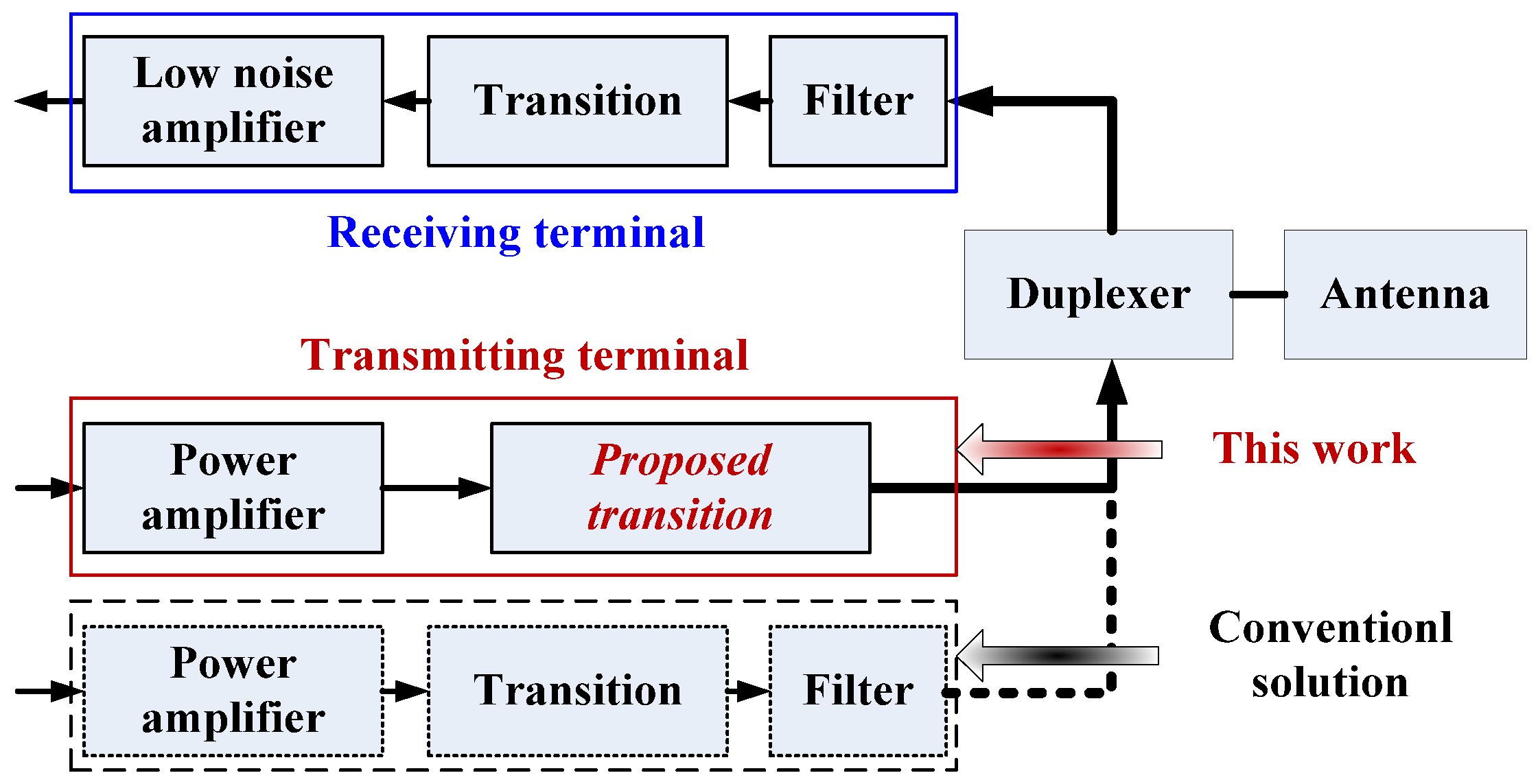
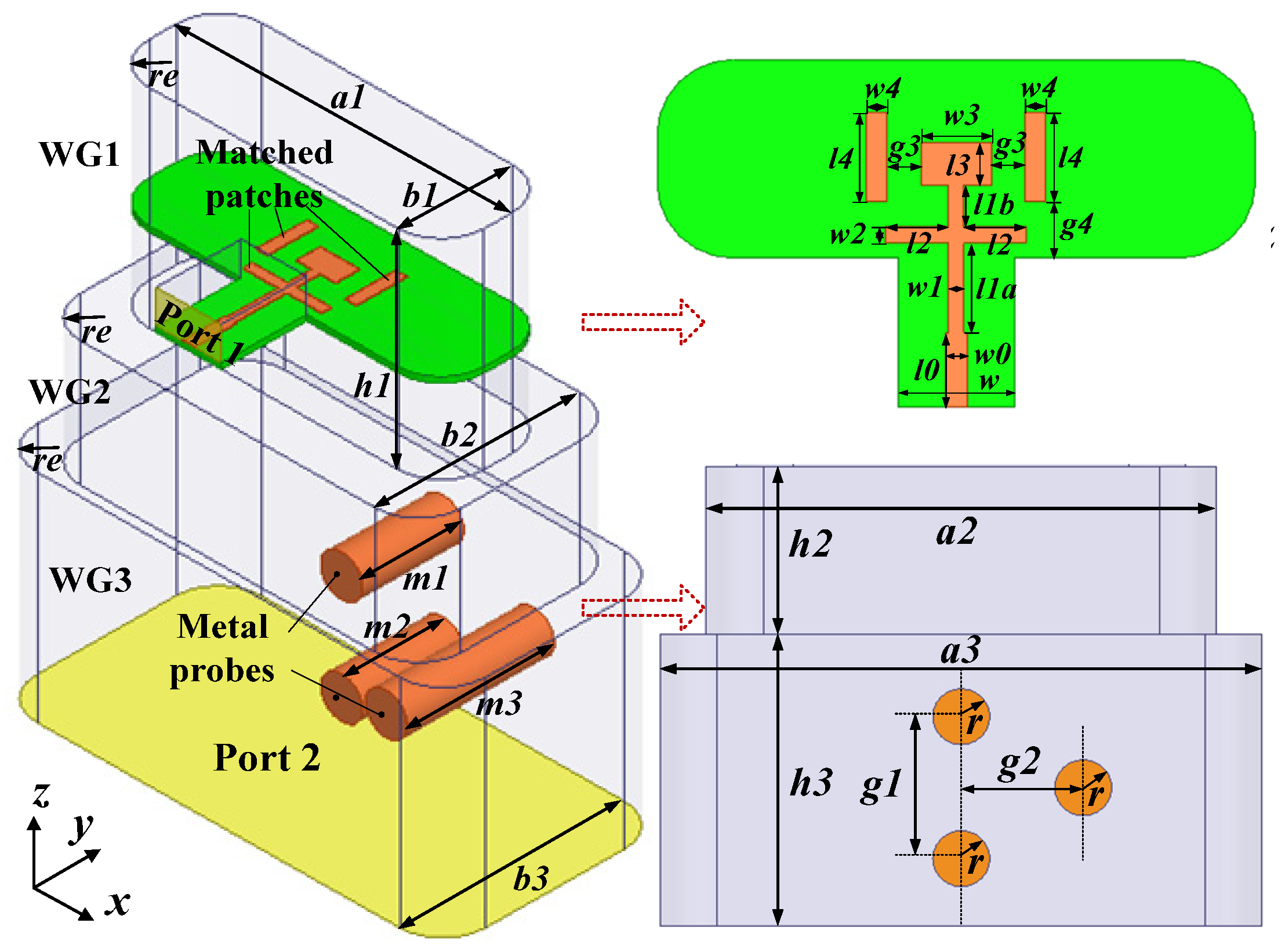
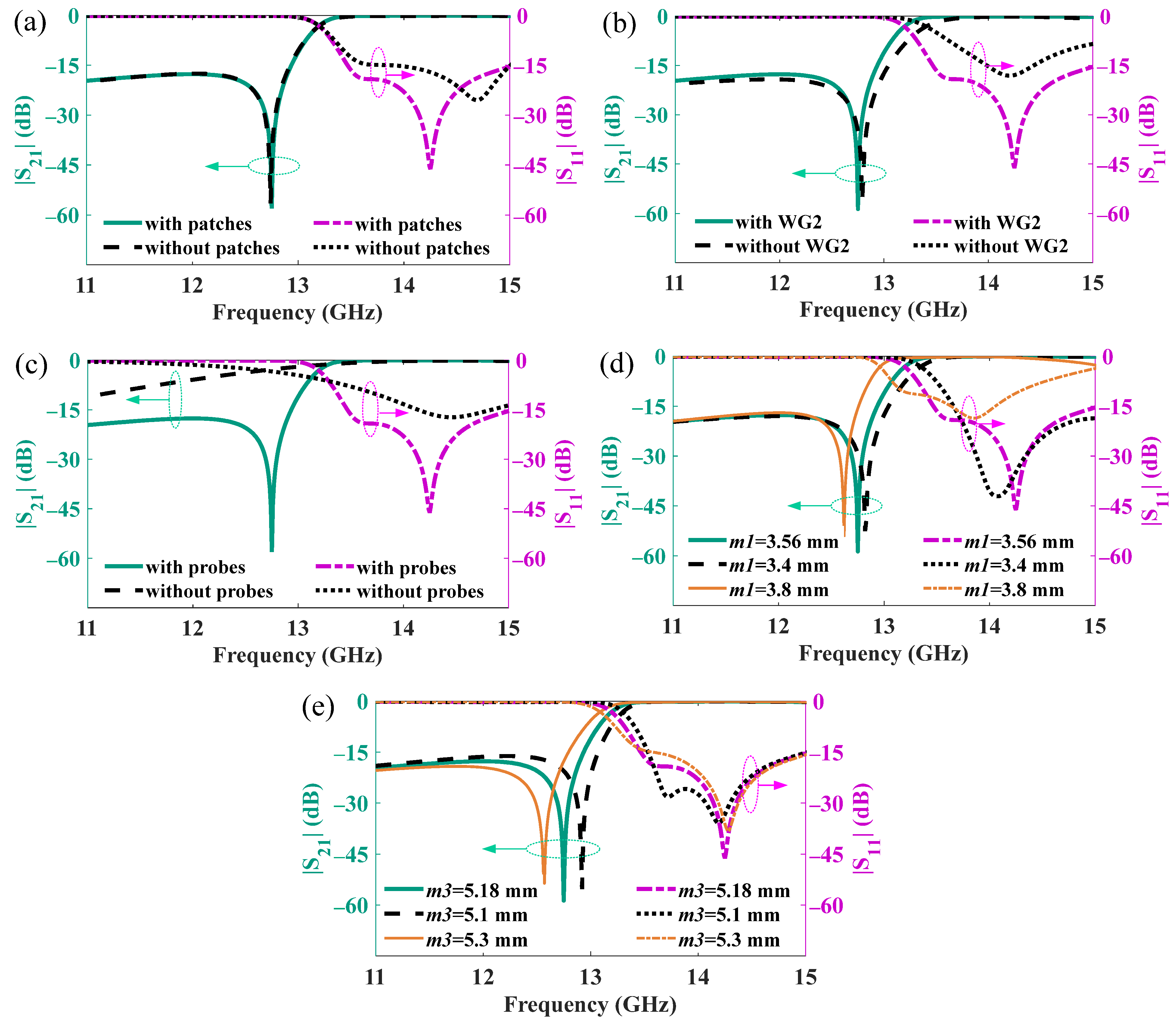
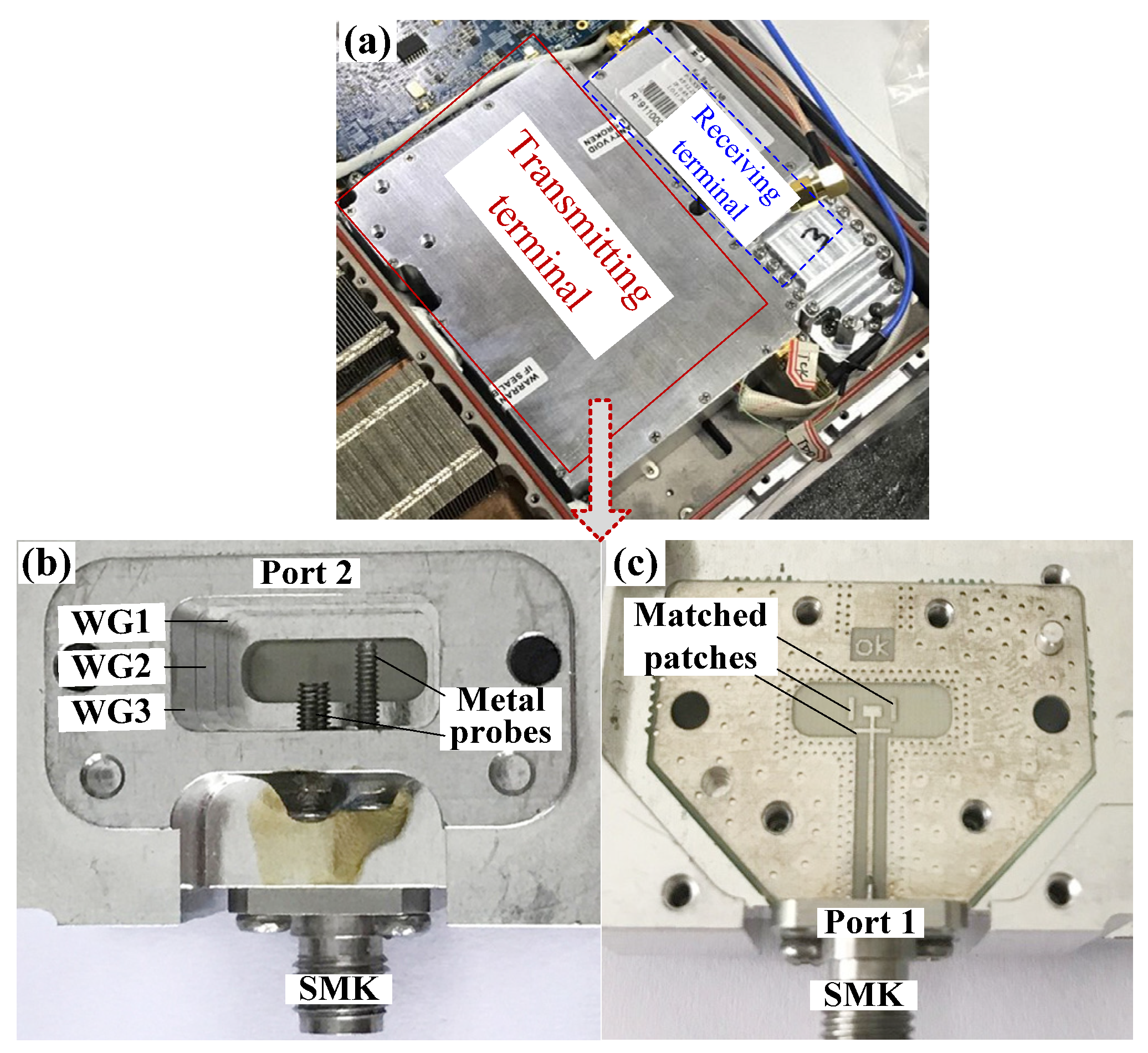
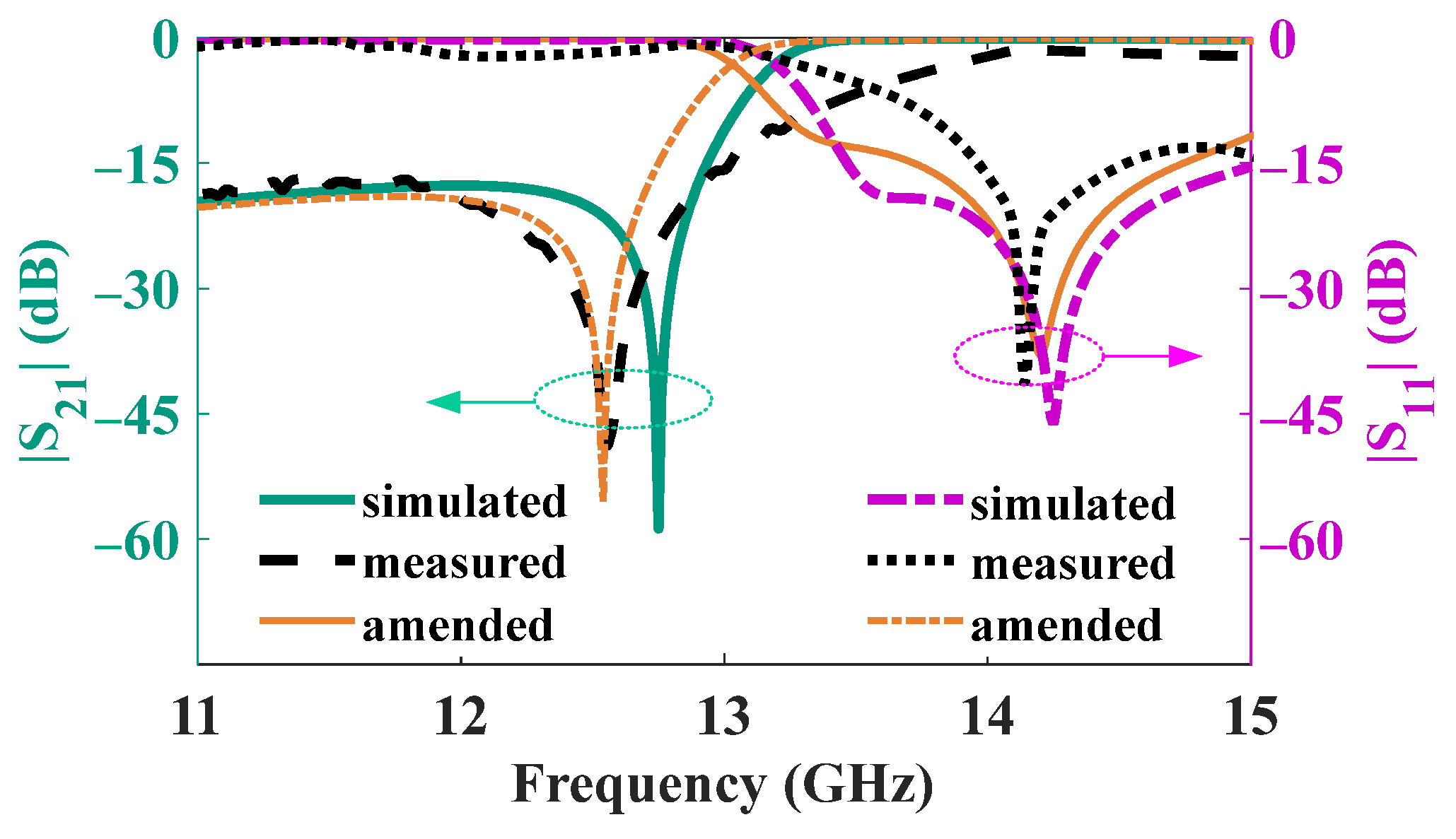
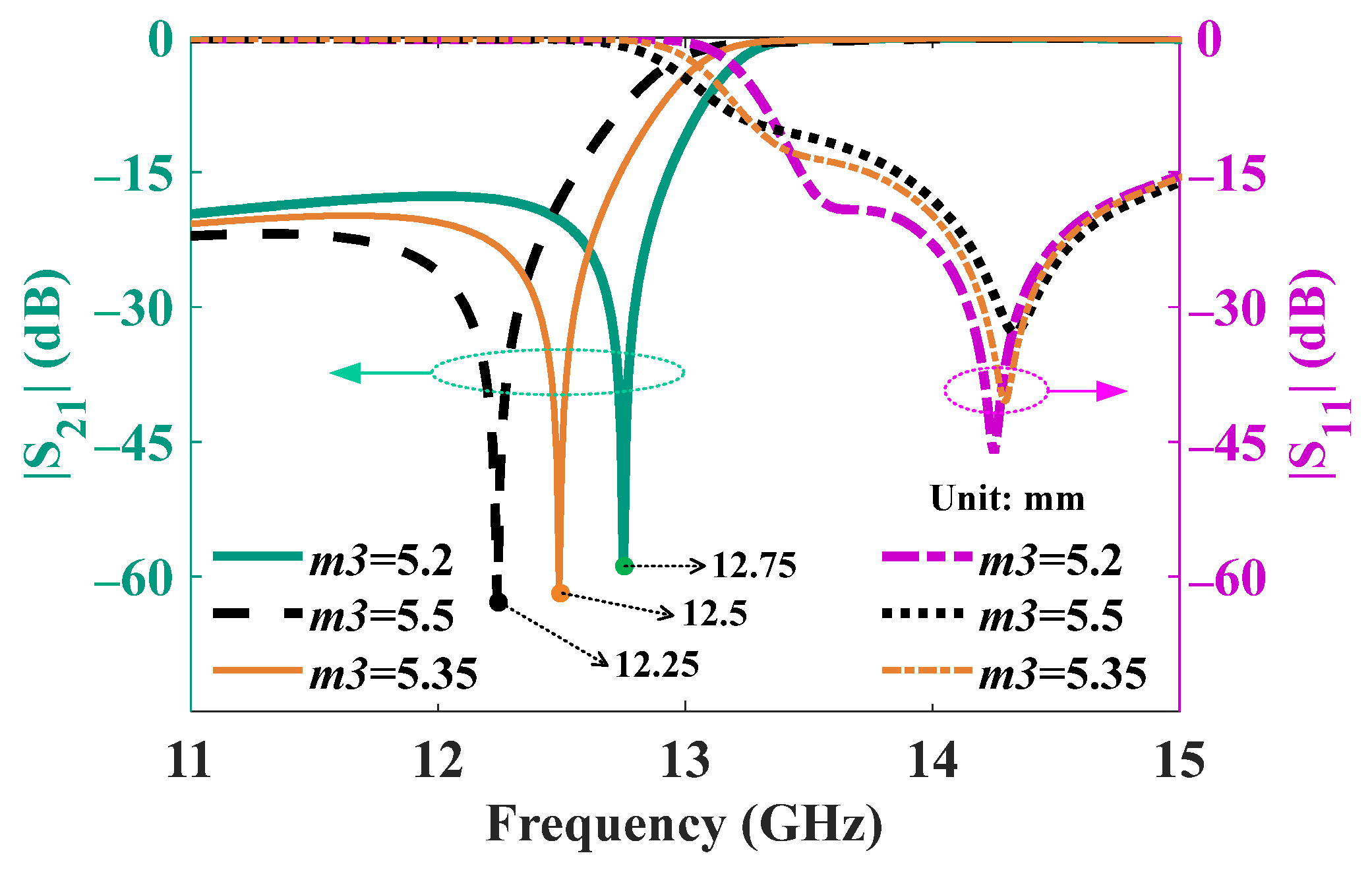
| Parameter | Value (mm) | Parameter | Value (mm) |
|---|---|---|---|
| a1 | 11.8 | g2 | 3.2 |
| b1 | 4 | a3 | 15.8 |
| h1 | 7.5 | b3 | 7.9 |
| m1 | 3.56 | h3 | 7.8 |
| g1 | 3.8 | g3 | 0.67 |
| g4 | 1.14 | l0 | 1.5 |
| w1 | 0.3 | l1b | 0.84 |
| w2 | 0.34 | w4 | 0.4 |
| l2 | 1.24 | l4 | 1.8 |
| a2 | 13.4 | w0 | 0.42 |
| b2 | 7.2 | l1a | 1.8 |
| h2 | 4.5 | w3 | 1.4 |
| m2 | 3.56 | l3 | 0.85 |
| m3 | 5.18 | r | 0.75 |
| w | 2.3 | re | 1.5 |
| Refs. | Operating Band (GHz) | |S11| (dB) | Out-of-Band Suppression | Tunability |
|---|---|---|---|---|
| [19] | 11.7–18.7 | <−10 | ~20 dB @11.5 GHz | No |
| [20] | 8–14.5 | <−10 | ~29 dB @7 GHz | No |
| [21] | 8.75–12.4 | <−13 | Non | No |
| [23] | 8.58–12.01 | <−15 | ~8 dB @8 GHz | No |
| [26] | 12–18 | <−15 | Non | No |
| [30] | 33–36.7 | <−15 | ~20 dB @32 GHz | No |
| This work | 14–14.5 | <−10 | ~48 dB @12.55 GHz | Yes |
Disclaimer/Publisher’s Note: The statements, opinions and data contained in all publications are solely those of the individual author(s) and contributor(s) and not of MDPI and/or the editor(s). MDPI and/or the editor(s) disclaim responsibility for any injury to people or property resulting from any ideas, methods, instructions or products referred to in the content. |
© 2024 by the authors. Licensee MDPI, Basel, Switzerland. This article is an open access article distributed under the terms and conditions of the Creative Commons Attribution (CC BY) license (https://creativecommons.org/licenses/by/4.0/).
Share and Cite
Xiong, Y.; Gao, D.; Tang, X. A Tunable Microstrip-to-Waveguide Transition for Emergency Satellite Communication Systems. Electronics 2024, 13, 4370. https://doi.org/10.3390/electronics13224370
Xiong Y, Gao D, Tang X. A Tunable Microstrip-to-Waveguide Transition for Emergency Satellite Communication Systems. Electronics. 2024; 13(22):4370. https://doi.org/10.3390/electronics13224370
Chicago/Turabian StyleXiong, Ying, Dawei Gao, and Xianfeng Tang. 2024. "A Tunable Microstrip-to-Waveguide Transition for Emergency Satellite Communication Systems" Electronics 13, no. 22: 4370. https://doi.org/10.3390/electronics13224370
APA StyleXiong, Y., Gao, D., & Tang, X. (2024). A Tunable Microstrip-to-Waveguide Transition for Emergency Satellite Communication Systems. Electronics, 13(22), 4370. https://doi.org/10.3390/electronics13224370









